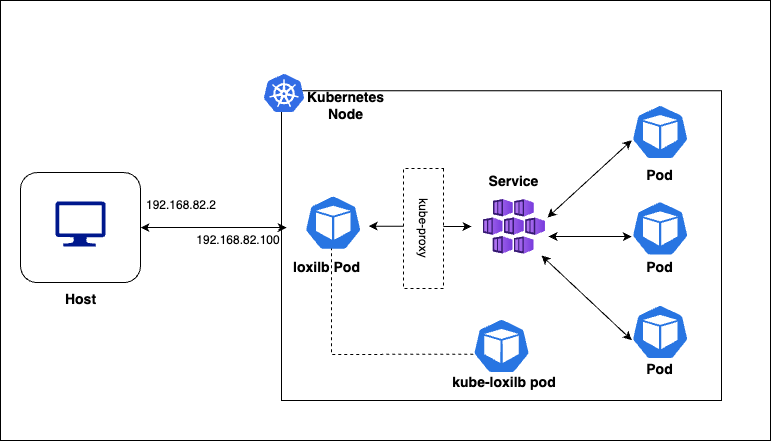Quick Start Guide with MicroK8s and LoxiLB in-cluster mode
This document will explain how to install a MicroK8s cluster with loxilb as a serviceLB provider running in-cluster mode.
Prerequisite(s)
- Single node with Linux
Topology
For quickly bringing up loxilb in-cluster and MicroK8s, we will be deploying all components in a single node :

loxilb and kube-loxilb components run as pods managed by kubernetes(MicroK8s) in this scenario.
Setup MicroK8s in a single-node
# MicroK8s installation steps
sudo apt-get update
sudo apt install -y snapd
sudo snap install microk8s --classic --channel=1.28/stable
Check MicroK8s status
$ sudo microk8s status --wait-ready
microk8s is running
high-availability: no
datastore master nodes: 127.0.0.1:19001
datastore standby nodes: none
addons:
enabled:
dns # (core) CoreDNS
ha-cluster # (core) Configure high availability on the current node
helm # (core) Helm - the package manager for Kubernetes
helm3 # (core) Helm 3 - the package manager for Kubernetes
disabled:
cert-manager # (core) Cloud native certificate management
cis-hardening # (core) Apply CIS K8s hardening
community # (core) The community addons repository
dashboard # (core) The Kubernetes dashboard
gpu # (core) Automatic enablement of Nvidia CUDA
host-access # (core) Allow Pods connecting to Host services smoothly
hostpath-storage # (core) Storage class; allocates storage from host directory
ingress # (core) Ingress controller for external access
kube-ovn # (core) An advanced network fabric for Kubernetes
mayastor # (core) OpenEBS MayaStor
metrics-server # (core) K8s Metrics Server for API access to service metrics
minio # (core) MinIO object storage
observability # (core) A lightweight observability stack for logs, traces and metrics
prometheus # (core) Prometheus operator for monitoring and logging
rbac # (core) Role-Based Access Control for authorisation
registry # (core) Private image registry exposed on localhost:32000
rook-ceph # (core) Distributed Ceph storage using Rook
storage # (core) Alias to hostpath-storage add-on, deprecated
How to deploy loxilb ?
loxilb can be deloyed by using the following command in the MicroK8s node
sudo microk8s kubectl apply -f https://raw.githubusercontent.com/loxilb-io/loxilb/main/cicd/microk8s-incluster/loxilb.yml
How to deploy kube-loxilb ?
kube-loxilb is used as an operator to manage loxilb.
wget https://raw.githubusercontent.com/loxilb-io/loxilb/main/cicd/microk8s-incluster/kube-loxilb.yml
kube-loxilb.yaml
args:
#- --loxiURL=http://172.17.0.2:11111
- --externalCIDR=192.168.82.100/32
- --setRoles=0.0.0.0
#- --monitor
#- --setBGP
In the above snippet, loxiURL is commented out which denotes to utilize in-cluster mode to discover loxilb pods automatically. External CIDR represents the IP pool from where serviceLB VIP will be allocated.
Apply after making changes (if any) :
sudo microk8s kubectl apply -f kube-loxilb.yaml
Create the service
sudo microk8s kubectl apply -f https://raw.githubusercontent.com/loxilb-io/loxilb/main/cicd/microk8s-incluster/tcp-svc-lb.yml
Check status of various components in MicroK8s node
In MicroK8s node:
## Check the pods created
$ sudo microk8s kubectl get pods -A
NAMESPACE NAME READY STATUS RESTARTS AGE
kube-system calico-node-fjfvz 1/1 Running 0 10m
kube-system coredns-864597b5fd-xtmt4 1/1 Running 0 10m
kube-system calico-kube-controllers-77bd7c5b-4kldr 1/1 Running 0 10m
kube-system loxilb-lb-7xctp 1/1 Running 0 9m11s
kube-system kube-loxilb-6f44cdcdf5-4864j 1/1 Running 0 7m40s
default tcp-onearm-test 1/1 Running 0 6m49s
## Check the services created
$ sudo microk8s kubectl get svc
NAME TYPE CLUSTER-IP EXTERNAL-IP PORT(S) AGE
kubernetes ClusterIP 10.152.183.1 <none> 443/TCP 18m
tcp-lb-onearm LoadBalancer 10.152.183.216 llb-192.168.82.100 56002:32186/TCP 14m
In loxilb pod, we can check internal LB rules:
$ sudo microk8s kubectl exec -it -n kube-system loxilb-lb-7xctp -- loxicmd get lb -o wide
| EXT IP | SEC IPS | PORT | PROTO | NAME | MARK | SEL | MODE | ENDPOINT | EPORT | WEIGHT | STATE | COUNTERS |
|----------------|---------|-------|-------|-----------------------|------|-----|--------|-----------|-------|--------|--------|----------|
| 192.168.82.100 | | 56002 | tcp | default_tcp-lb-onearm | 0 | rr | onearm | 10.0.2.15 | 32186 | 1 | active | 25:1842 |
Connect from host/client
$ curl http://192.168.82.100:56002
<!DOCTYPE html>
<html>
<head>
<title>Welcome to nginx!</title>
<style>
html { color-scheme: light dark; }
body { width: 35em; margin: 0 auto;
font-family: Tahoma, Verdana, Arial, sans-serif; }
</style>
</head>
<body>
<h1>Welcome to nginx!</h1>
<p>If you see this page, the nginx web server is successfully installed and
working. Further configuration is required.</p>
<p>For online documentation and support please refer to
<a href="http://nginx.org/">nginx.org</a>.<br/>
Commercial support is available at
<a href="http://nginx.com/">nginx.com</a>.</p>
<p><em>Thank you for using nginx.</em></p>
</body>
</html>
For more detailed information on incluster deployment of loxilb with bgp in a full-blown cluster, kindly follow this blog.
All of the above steps are also available as part of loxilb CICD workflow. Follow the steps below to replicate the above (please note that you will need vagrant tool installed to run:
$ git clone https://github.com/loxilb-io/loxilb.git
$ cd cicd/microk8s-incluster/
# To setup the single node microk8s setup and loxilb in-cluster
$ ./config.sh
# To validate the results
$ ./validation.sh
# To login to the node and check the installation
$ vagrant ssh k8s-node1
# Cleanup
$ ./rmconfig.sh